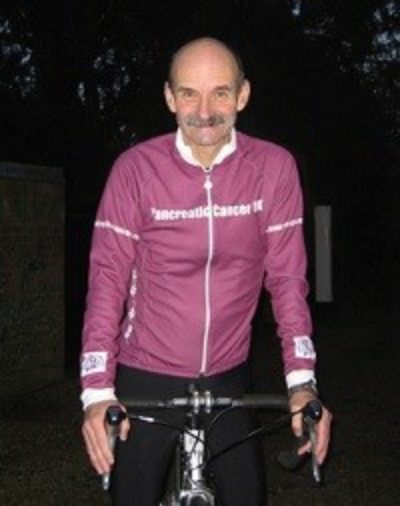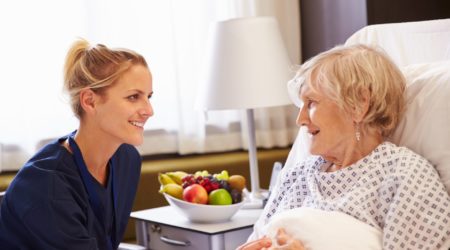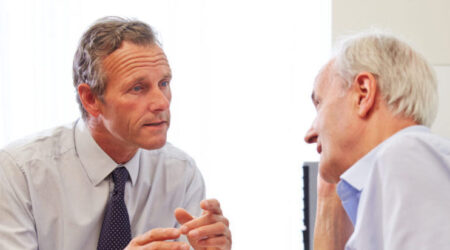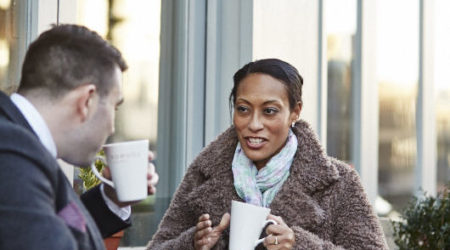



Trace
Trace, 60 when diagnosed with inoperable adenocarcinoma of the head of the pancreas. It was rendered operable by chemotherapy and chemo-radiotherapy.
I have been physically fit all my life; County Cross-Country runner, football, athletics. I’ve run more than 100 half marathons including 21 Great North Runs, London Marathons and International Triathlons.
I had severe stomach pains in Italy which I put down to an awful food experience on Alitalia. I tried to run it off though this didn’t work. At my Triathlon Club’s local race the following week I did badly and had to walk. I felt below par, sluggish, generally ill. I started to get strong stomach pains and had to lie down to alleviate the pain, something that for me is unheard of. I decided to take a week off and go to Catalunya.
My stomach pains began to ease as my urine began to become gradually darker yellow by the day. I also had smelly diarrhoea. I thought I was dehydrated and started to drink a lot more water. This had the effect of decreasing the intensity of colour of my urine by day though by morning its colour had darkened again. I had intended to run in my 22nd Great North Run the following Sunday. I arrived back in the UK and my wife told me the whites of my eyes had gone yellow and that my suntan gained in Greece and Italy had visibly darkened. It was the calm before the storm!
As my GP was closed on Saturday I immediately consulted NHS Direct who advised me to go straight to the nearest A&E as it sounded as if I had jaundice. I was kept in hospital overnight ‘for observation’. I was put on a saline drip which was a frightening experience as it immediately branded me as ‘ill’; I had a restless night though pain free. I felt like a fraud and decided that others needed the bed more than I. I got myself discharged and became an outpatient. This might have been a mistake as the tests and scans scheduled were delayed because I had become an outpatient! First thing on Monday morning I went to see my GP and we discussed the possible causes of the Jaundice as outlined by the A&E; Hepatitis, Gallstones or another obstruction of the bile-duct, or something viral.
I decided not to wait and had an Ultrasound done privately at the local Bupa Hospital. The Technician there was impressively thorough and told me within five minutes that he had found ‘something’ and would be reporting to my GP that afternoon. My GP told me that I should await the results of the blood tests which were expected imminently though a ‘mass’ had been detected on the Pancreas by the Ultrasound the previous day.
I was very impressed by the speed the GP and the system worked as by the next day the blood test results showed very high levels of bilirubin (bile) had been found in the blood together with high levels of liver enzymes. This finding was consistent with a blocked bile duct.
The GP referred me to a specialist gastroenterologist at the local hospital for the following Tuesday. The consultation didn’t last long; there was a physical evaluation, I was told I was underweight (although the weight was pretty normal for me). I was suffering from Obstructive Jaundice caused by the mass on the Pancreas. I was ready for it when I was told I had Cancer of the Pancreas.
I didn’t know whether to be devastated that my life might end soon or relieved that at least a cause had been found for the increasingly debilitating effect of the Jaundice which by now was causing significant discomfort through skin irritation and itching all over my body. This gradually became worse and within a week I was a physical wreck, unable to sleep and constantly scratching. I found this on reflection to be one of the lowest points of the process and my life to-date!
Further tests were needed to learn more and determine treatment. I was to have an endoscopic procedure to examine the bile duct, take samples of the tumour and put a stent into the bile duct so that the bile could be drained away to relieve the symptoms of Jaundice. During the UCH gastro-enterology team meeting the same week my case was discussed and I was informed that a surgical route was indicated. An appointment to see the surgeon was arranged within a week.
This short hiatus allowed the wedding plans of my daughter to go ahead as scheduled. We threw a large wedding-party where the magnificent Bernie Marsden (he of Whitesnake fame) played for us. I thought this might be my last hoorah-though he told me in a quiet moment that I had to believe in Rock n’ Roll and everything would be ok. He played me Honky Tonk Woman (Stones) and Wonderful Tonight (Eric Clapton) and I actually believed him!!
The day after the wedding I met the surgeon. And we discussed the prognosis and the plan to go ahead with a pancreaticoduodectomy (also known as a Whipples Operation). On 6th November, about six weeks since I had gone yellow and 5 days before my 60th birthday I was admitted to the London Clinic ready for the operation the next day. The preliminary tests on admission revealed that I was also an undiagnosed diabetic.
Operation 1 – Biliary and gastric bypass
The operation was shorter than anticipated lasting about 3 hours rather than the expected 5-6 hours needed to remove the tumour. Th duodenum and gall bladder as well as a valve in the stomach had all been removed. However the surgeon told me that the tumour was wrapped around the portal vein and therefore a resection at the head of the pancreas was not performed. It was deemed inoperable!
I think I was expected to be deflated by this news. I was not really dismayed. I was extremely relieved that the jaundice had gone and I knew that chemotherapy was to follow. I also strongly remembered the strength of mind and courage showed by 7 times Tour de France winner Lance Armstrong in his book (‘It’s not about the Bike’).
Downsizing the tumour after Operation 1
My extremely positive surgeon said there may be cause for hope in the form of an experimental treatment they were trying to shrink or downstage the tumour off the vein so that it would become operable. The treatment was to involve chemotherapy and chemo-radiotherapy.
The Oncologist from UCH came to see me while I was still in the hospital to explain to me the treatment he was recommending. Additionally, my level of general fitness, even after the surgery, was sufficiently high that the therapy was to begin almost immediately. And within about a week of surgery the Chemotherapy began. The Chemotherapy consisted of an 8 week course of Gemcitabine and Capecitabine. (Given in two cycles of 3 weeks followed by one week off for recovery). Given the inoperability of the tumour, I had a great feeling of elation each time I had the Capecitabine (3 times daily). At last, I thought I am fighting back.
There were some minor side effects of general debility which built up over the 8 week period. By the end of the two cycles the skin at the bottom of my feet was cracking particularly on the heel. There was surprisingly little other negative effect, I thought.
There was then a 2-3 week period of ‘settling’ after which an analysis of what had been achieved was carried out. A CT scan was conducted which showed the tumour had reduced in size to 60% of its original!
I decided to tell as many people as I could and I received a massive level of support and encouragement. I am greatly indebted to my friends from the Garden City Runners club and Tri-Force Triathlon club for encouraging me to set some new and challenging sporting goals and for recommending me to get support and information from Pancreatic Cancer UK. I decided that I would set a goal of completing a Triathlon during the season and a cross country run before the winter was over.
I woke up each day thinking ‘right, here’s another day when it’s going to get zapped’. Every day I opened the window and shouted out ‘It’s another miracle. It’s another day’ something I had read Einstein used to do.
Chemo-radiotherapy treatment is (as I understand it) relatively common in the US and many other European countries though it is not so common in England. In my case the therapy was designed to help shrink the tumour further such that it could later be surgically removed. In principle, the therapy consists of radiation treatment while taking chemo drugs. I am indebted to Bupa for funding of this and other treatments related in this Case study.
The Radiotherapy was conducted at Mount Vernon by specialists. I was to have 28 days of irradiation treatment. This was spread over a period of about 6 weeks. It meant daily treatment except for the weekend so that the body (and the Radiologists) could recover somewhat. On the third day of each week I was to have an infusion of Gemcitabine fluid to enhance the radiation effectiveness as the drug would migrate to the diseased area and act as a ‘target’ for the irradiation dosage.
Again there was a general build-up of the feeling of debilitation over the period of the treatment. I began to lose all sense of taste and many of the foods that I had been enjoying became difficult for me to face. I became tired easily and spent more time resting and generally feeling unwell particularly towards the end of the treatment. However, I was able to withstand the treatment pretty well and the generally positive attitude of the Marie Curie Staff and Radiographers was a real tonic, to me and to the other patients.
At the conclusion of the combined Chemo and Radiation treatment, CT scans showed the tumour had been ‘flattened’ which I took to mean that it was no longer detectable as a ‘lump’. Me. I was over the moon with delight-to use a football parlance!
By the end of February, some 3 months from the first surgery, the wound had healed over. I started to do daily stints on my exercise bike as soon as I could in January and by early February I was running again, albeit rather tentatively, in Cross Country runs.
Operation 2: Whipple’s Operation
There followed a period of recuperation which lasted from the end of the Chemo-Radiotherapy in March through to May when I had the follow up surgery. During this five week period I went back to swimming twice a week, biking for about 90 minutes a week and running as often as I could muster. My surgeon and Oncologist told me that I had the best chance of surviving and recovering quickly if my heart was in the best possible shape. Two weeks before the surgery date, I completed a sprint triathlon and though it wasn’t too quick I finished in 2nd position in my age group (old men!) and came home with a plaque to prove it!
I was readmitted to the London Clinic on 20th May 2005 ready for the Operation to remove the tumour on the next day. It operation was conducted thankfully by the same team from UCH, it lasted about 5 hours and was a success. The remaining apparently dormant tumour was cut from the head of the pancreas and portal vein which required re-sectioning (also something of a rarity in such circumstances I am told). The remaining pancreas was sewn into the stomach where it would be more ‘stable’ and therefore the bile duct could remain in its repositioned place in the intestine.
This time the histology reports on the liver tissue, the tumour and the surrounding areas showed the disease to be absent. I was totally elated of course!
I was to complete the protocol of Chemotherapy started after the first Operation in December 2004, six months previously. The same chemotherapy ingredients Gem/Cap were used and it was explained that this further chemotherapy was designed to mop up any malignant cells to help prevent a recurrence of the disease and at the same time complete the ‘trial’ protocols.
This chemotherapy treatment began almost immediately, two weeks later in late June and was all over by mid October.
Although I became gradually more debilitated as the Chemo treatment continued, I decided I had to get back to the pool and onto my exercise bike. So by the end of the 2nd cycle in August I was also running for about 30 minutes once or twice a week and swimming for about one hour per week. The final infusion of Gemcitabine took place in October 2005 and the following weekend I ran in my first serious Cross Country race at Cheshunt (5 miles) for more than a year.
With the CT scans and blood test results showing I was clear of the disease I began to increase my running activities. On 2nd January 2006, 6 months after the 2nd Op and 2 months after completing the Chemotherapy, I rejoined my Triathlon club team mates at TriForce for a full two weeks training!
Traditionally, I had always run the Buntingford 10 mile run in December and although quite slow I was absolutely delighted to finish and in one piece!
I decided my dear wife needed a break and a holiday so I broke the bank and took her away for two weeks to the Caribbean at the end of January 2006. I felt very well and seemed to have got my appetite back at last. I had arranged to have a follow up CT scan and blood test the week I got back as the three month follow up was already due and the CT scan showed I was clear of the disease. It was one of the best days I could ever remember since Aston Villa won the European Cup in Rotterdam in 1982!
However the blood test results indicated that the liver enzymes were higher than normal. In this case the most likely cause was deemed to be a partial blockage of the bile duct particularly as the bile levels were almost normal.
An MRI scan confirmed a narrowing of the bile duct and so the following week a tube was inserted under mild sedation in my chest, through the liver and into the bile duct. Real time x-ray guided a wire in the tube to the restricted spot though no way through was found. A second attempt under general anaesthetic two days later and a final attempt using endoscopy also failed the following week.
The remaining option to remove the restriction in the Bile Duct, was surgery. The cause of the blockage had been ascribed to excessive build-up of scar tissue caused by surgery .On April 1st 2006, and not a date I would have chosen myself, I was readmitted to The London Clinic. The procedure went well the damaged material was cut away and the bile duct rejoined.
I have tried very hard with the great help and support of my wife to follow a low GI diet. Generally speaking, I have kept away from processed food wherever possible and used carbohydrate, chicken for protein, fresh vegetables and fruit as my staples. I have kept my alcohol intake down though not abstemiously. By following these sorts of diet I have been able to keep the blood sugar level generally down which clearly helps control the diabetes.
The bottom line is to stay positive, and never give up hope. Hope does overcome all fear and helps us to fight and attack back!
This case study is dedicated to my wife, Joy Allen without whose unstinting care, advice, support and attention I would have found survival much more difficult.
May 2011




